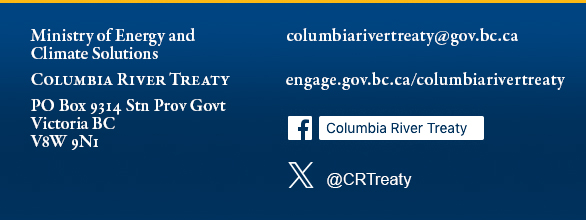Columbia River Treaty
Edition: Updated April 2021

Integrating social and economic interests in Columbia River management modelling
Apr 27, 2021
Negotiating a transboundary water treaty is a complicated undertaking. There are many different, often competing, factors to consider. As Canada, B.C. and the Columbia Basin Indigenous Nations collaborate on positions and options for a modernized Columbia River Treaty, a new computerized model aims to help them understand just how these factors are interconnected.
The project is the work of the Columbia River Treaty Negotiation Advisory Team (NAT), a group with representatives from Canada, B.C. and Basin Indigenous Nations that provides advice and information to Canada’s negotiating team. A technical working group reporting to the NAT has customized a computerized river management model to determine how different Treaty dam operations would affect ecosystems, Indigenous cultural values, power generation and the social and economic health of communities. This model will help Canadian negotiators see how U.S. proposals for Treaty changes could impact Basin interests, and explore what level of flexibility is needed for Canadian operations to improve conditions in B.C.
The model uses performance measures to evaluate how different river management scenarios can affect Basin interests. Indigenous Nations are developing performance measures for ecosystems, along with B.C. and federal government staff and environmental scientists (Indigenous Nations and Basin residents have identified ecosystems as a top priority interest to be fully incorporated in the Treaty). Performance measures for Indigenous cultural values are also being developed by the Indigenous Nations. BC Hydro is creating modelling inputs for power generation and flood risk management. The development of socio-economic performance measures is being led by the Columbia River Treaty Local Governments’ Committee (LGC).
The LGC project team began their process by determining which factors to consider. To do this, they reviewed reports from the Province’s past Columbia River Treaty community meetings, and identified the following socio-economic interests, raised by Basin residents, that could be impacted by river flows and/or reservoir water levels managed under the Treaty:
- flooding;
- erosion;
- navigation;
- recreation and tourism;
- health (dust generation); and
- agriculture.
The team then compiled the relevant performance measures used by BC Hydro in past scenario evaluation processes.
For example, when reservoir levels are low and winds are high, dust storms can become a health hazard. A performance measure for dust generation on a specific reservoir documents the number of days, during a defined timeframe, when the reservoir water level is below a specified elevation, thus exposing areas that could generate dust storms. The computer model takes this information and reports whether different river management scenarios would increase or reduce the health hazard.
An initial summary of the interests and potential performance measures has been shared for feedback with the LGC and the Columbia Basin Regional Advisory Committee.
In the fall, the LGC project team will host public webinars to explain the process and invite broader input. Revisions based on this input will be included in recommendations to the NAT before the end of 2021.
Learn more about this project at www.crtlgc.ca/socio-economic-integration.
Learn more about the CRT Local Governments’ Committee and their work at www.crtlgc.ca.
Contact the LGC with questions, comments or feedback at: https://www.crtlgc.ca/contact-us.


